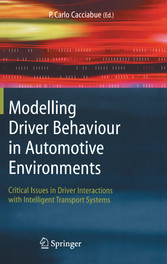Suchen und Finden
Service
Modelling Driver Behaviour in Automotive Environments - Critical Issues in Driver Interactions with Intelligent Transport Systems
Carlo Cacciabue
Verlag Springer-Verlag, 2010
ISBN 9781846286186 , 441 Seiten
Format PDF, OL
Kopierschutz Wasserzeichen
"V Modelling Risk and Errors 13 Time-Related Measures for Modelling Risk in Driver Behaviour (p. 234-236)
RICHARD VAN DER HORST
13.1 Introduction
Accident statistics have an important general safety monitoring function and form a basis for detecting specific traffic safety problems. However, the resulting information is inadequate for analysing and diagnosing, defining remedial measures and evaluating their effects. Systematic observations of driver behaviour, combined with knowledge of human information-processing capabilities and limitations, offer wider perspectives in understanding the causes of safety problems and modelling driver behaviour in both normal and critical situations.
Renewed interest results from the need to develop, test, assess and evaluate driver support systems in terms of drivers behaviour, performance and acceptance. The processes that result in near-accidents or traffic conflicts have much in common with the processes preceding actual collisions (Hyden, 1987); only the final outcome is different. The frequency of traffic conflicts is relatively high, and they offer a rich information source on causal relationships since the preceding process can be systematically observed. In this approach, traffic situations are ranked along a continuum ranging from normal situations, via conflicts to actual collisions.
A pyramidal representation of this continuum was introduced by Hyden (1987), clearly visualising the relative rate of occurrence of the different events (Fig. 13.1). The analysis of driver behaviour in critical encounters may not only offer a better understanding of the processes that ultimately result in accidents, but, perhaps even more efficient in the long run, also provide us with knowledge on drivers abilities of turning a critical situation into a controllable one.
A general conceptual description of the driving task as commonly used in traffic psychonomics, with time-to-line crossing (TLC) and time-to-collision (TTC) as a measure for describing the lateral and longitudinal driving task will be used to distinguish normal from critical behaviour. That may serve as realistic criterion settings for in-car warning systems such as forward collision warning and intersection collision avoidance warning systems.
13.2 The Driving Task
In the literature the task analy sis for driving a car is well documented. A frequently used conceptual model of the driving task consists of three hierarchically ordered levels, navigation, guidance and control (Allen et aI., 1971). In other publications these levels are also referred to as strategic, manoeuvring and control. Tasks at the navigat ion level refer to the activities related to planning and executing a trip from origin to destination. The need for processing information only occurs occasionally, with intervals ranging from a few minutes to hour s. The guidance level refer s to tasks deal ing with the interaction with both environment (roadway, traffic signs , traffic signals) and other road users. Activity is required rather frequently with intervals of a few seconds to a few minutes."



